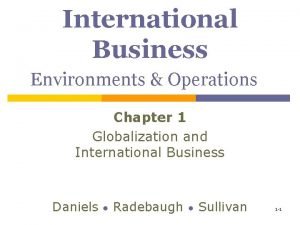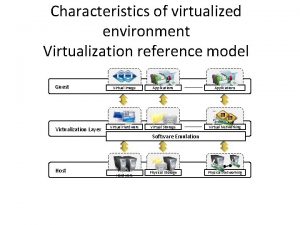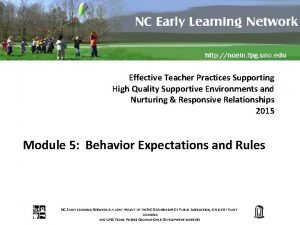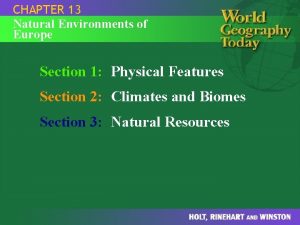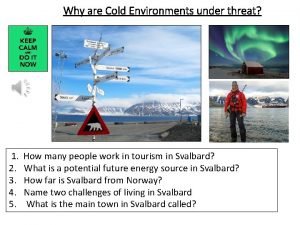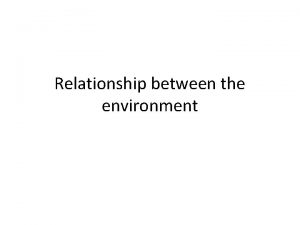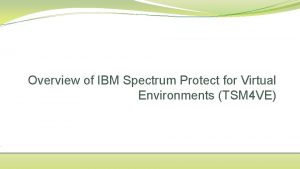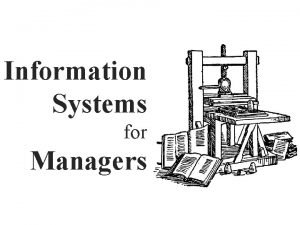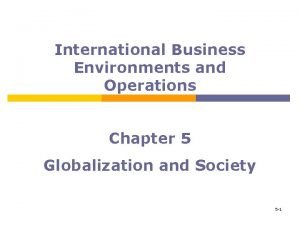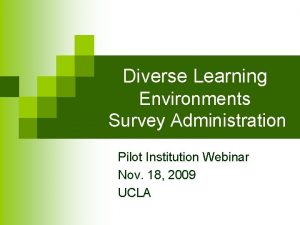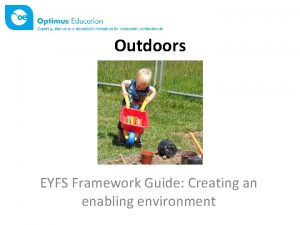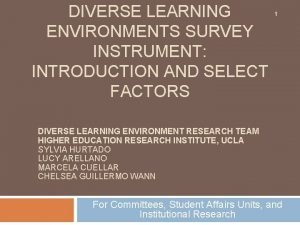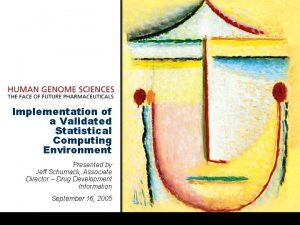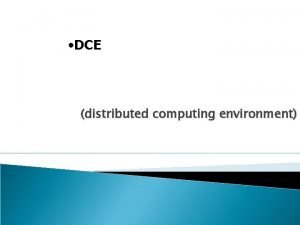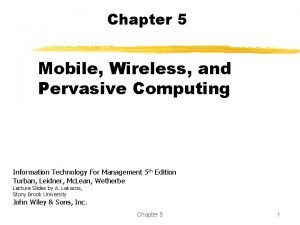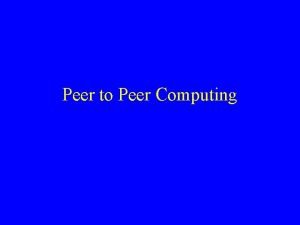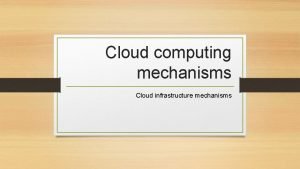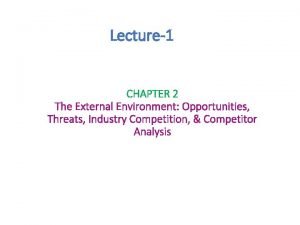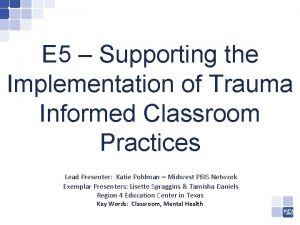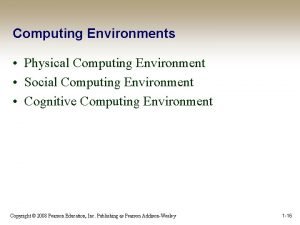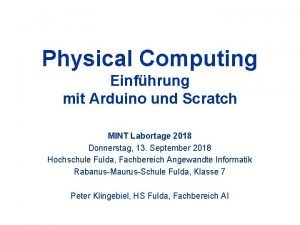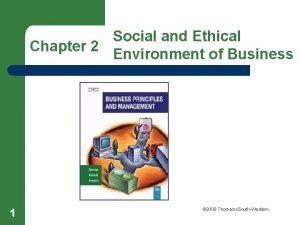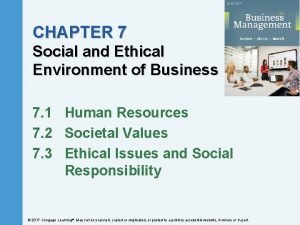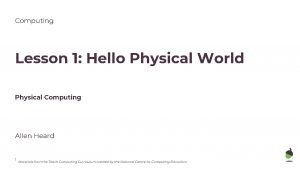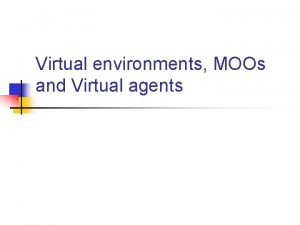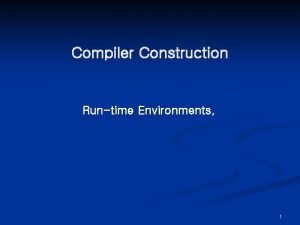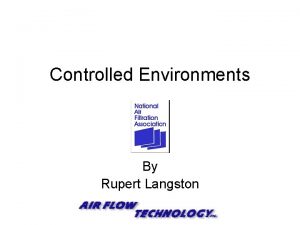Computing Environments Physical Computing Environment Social Computing Environment

















































- Slides: 49

Computing Environments • Physical Computing Environment • Social Computing Environment • Cognitive Computing Environment Copyright © 2008 Pearson Education, Inc. Publishing as Pearson Addison-Wesley 1 -16

Computing Environments • Physical Computing Environment – – – – Safety Efficiency User Space Work Space Lighting Noise Pollution Default settings must be carefully thought out Copyright © 2008 Pearson Education, Inc. Publishing as Pearson Addison-Wesley 1 -17

Computing Environments • Social Computing Environment – The social environment affects the way people use computers. – Computer use has also been shown to affect human social interaction. – Different computing paradigms imply different social environments. • For instance, personal computing is usually a solitary activity done in an office or an isolated corner of the house. Mobile computing is often done outside and in public places Copyright © 2008 Pearson Education, Inc. Publishing as Pearson Addison-Wesley 1 -18

Computing Environments • Cognitive Computing Environment – Age – Disabilities – Degree of technical knowledge – Degree of focus – Cognitive Stress Copyright © 2008 Pearson Education, Inc. Publishing as Pearson Addison-Wesley 1 -19

Analyzing Interaction Paradigms • 5 W + H – What/How – Where/When – Who/Why Copyright © 2008 Pearson Education, Inc. Publishing as Pearson Addison-Wesley 1 -20

Interaction Paradigms • • Large Scale Computing Personal Computing Networked Computing Mobile Computing Collaborative Environments Virtual Reality Augmented Reality Copyright © 2008 Pearson Education, Inc. Publishing as Pearson Addison-Wesley 1 -23

• • FINal projects A) Assigned groups B) Make your own group C) Indifferent Copyright © 2008 Pearson Education, Inc. Publishing as Pearson Addison-Wesley 1 -24

Interaction Paradigms Large circles represent principal paradigms. Oblong shapes represent convergent paradigms. Words without surrounding shapes represent specific system architectures (sometimes used for a paradigm reference, as in desktop computing for personal computing). Copyright © 2008 Pearson Education, Inc. Publishing as Pearson Addison-Wesley 1 -25

Large Scale Computing • The original mainframe computers were large-scale computing machines, referred to as hosts • They resided in a central location • They were accessed by remote alphanumeric terminals equipped with keyboards – The terminals were referred to as “dumb terminals” – These systems are also referred to as host/terminal systems Copyright © 2008 Pearson Education, Inc. Publishing as Pearson Addison-Wesley 1 -26

Large Scale Computing • They were programmed using punch cards IBM card punch machines. Courtesy IBM Corporate Archives. • Time-sharing services (TSSs) were schemes that used the downtime of one user for another user who was currently active. Copyright © 2008 Pearson Education, Inc. Publishing as Pearson Addison-Wesley 1 -27

Large Scale Computing • Mainframe computers are currently used in enterprise computing environments like Wall Street • IBM Mainframes photo album Copyright © 2008 Pearson Education, Inc. Publishing as Pearson Addison-Wesley 1 -28

Large Scale Computing • Super Computers – These highly specialized machines crunch large amounts of data at high speed, as in computing fluid dynamics, weather patterns, seismic activity predictions, and nuclear explosion dynamics. – Supercomputers are used for the very high speed backbone (v. BNS) connections that constitute the core of the Internet. National Center for Super Computing Applications (NCSA) Copyright © 2008 Pearson Education, Inc. Publishing as Pearson Addison-Wesley 1 -29

Personal Computing • Desktop Computing The Alto, developed at the Xerox Palo Alto Research Center in 1973, was the first computer to use a GUI that involved the desktop metaphor: pop-up menus, windows, and icons The Xerox Alto computer (1973) Courtesy Palo Alto Research Center. Copyright © 2008 Pearson Education, Inc. Publishing as Pearson Addison-Wesley 1 -30

Personal Computing The Xerox Alto mail program (1973) The Xerox Alto computer (1973) Copyright © 2008 Pearson Education, Inc. Publishing as Pearson Addison-Wesley Courtesy Palo Alto Research Center . 1 -31

Personal Computing • Personal-Public Computing – Public Access Computing – The information divide – Public Information Appliances Automated teller machine with touchscreen. Courtesy Big. Stock. Photo. com Copyright © 2008 Pearson Education, Inc. Publishing as Pearson Addison-Wesley 1 -32

Networked Computing • Licklider – The Galactic Network • ARPAnet - 10: 30 pm on October 29, 1969 • Scope – – WAN – Wide Area Network MAN – Metropolitan Area Network LAN – Local Area Network PAN – Personal Area Network • Wired - Wireless – Wi-Fi (IEEE 802. 11 x) – Bluetooth – 3 G Copyright © 2008 Pearson Education, Inc. Publishing as Pearson Addison-Wesley 1 -33

Mobile Computing • Mobile computing technologies comprise a very diverse family of devices: – Laptop computers – Tablet computers – Game players – MP 3 players – PDAs – Cell phones Copyright © 2008 Pearson Education, Inc. Publishing as Pearson Addison-Wesley 1 -34

Mobile Computing Desktop metaphors do not translate well to mobile devices. MP 3 player Laptop computer Courtesy Big. Stock. Photo. com Tablet computer Cell phone Hybrid desktop/mobile environments can afford optimal interaction efficiency. Copyright © 2008 Pearson Education, Inc. Publishing as Pearson Addison-Wesley 1 -35

Mobile Computing • Mobile devices can be connected to global positioning systems (GPS) – These have touchscreens and voice interaction to alleviate potential visual attention problems during driving On-board navigation system. Courtesy Big. Stock. Photo. com Copyright © 2008 Pearson Education, Inc. Publishing as Pearson Addison-Wesley 1 -36

Mobile Computing • Mobile devices can offer situational computing that can take advantage of location-specific information through location-based mobile services (LMS). – LMS can be beneficial for location-sensitive advertisements, public service announcements, social interactions, and location-specific educational information. Copyright © 2008 Pearson Education, Inc. Publishing as Pearson Addison-Wesley 1 -37

Collaborative Environments • Networks allow members of a group to interact with other members on shared files and documents. – This creates a virtual space where people can collaborate and work collectively. – Groupware Networks facilitate collaborative activities. Copyright © 2008 Pearson Education, Inc. Publishing as Pearson Addison-Wesley 1 -38

Collaborative Environments • Collaborative work – – Communication Coordination Organization Presentation • Computer-mediated communication (CMC) • Computer-supported cooperative work (CSCW) • What are some of the different types of groupware? Copyright © 2008 Pearson Education, Inc. Publishing as Pearson Addison-Wesley 1 -39

Collaborative Environments • Remote interaction – Synchronous • • Video conferencing Instant messaging Chat rooms Remote access white boards – Asynchronous • Recommender systems • Bulletin boards • Email Copyright © 2008 Pearson Education, Inc. Publishing as Pearson Addison-Wesley 1 -40

Collaborative Environments • Face-to-face – Smart rooms • Projectors • Smart Boards Actalyst. TM interactive digital signage SMART Board. TM Interactive Whiteboard Copyright 2001 -2007 SMART Technologies Inc. All rights reserved Copyright © 2008 Pearson Education, Inc. Publishing as Pearson Addison-Wesley 1 -41

Collaborative Environments • Collaboratory (Laboratories without walls) – Developed to allow the scientific community to perform and share research projects and results regardless of physical location. • • The Research Collaboratory for Structural Bioinformatics (RCSB) The Chimpanzee Collaboratory The National Fusion Grid Space Physics and Aeronomy Research Collaboratory (SPARC) Copyright © 2008 Pearson Education, Inc. Publishing as Pearson Addison-Wesley 1 -42

Embodied Virtuality Some of us use the term “embodied virtuality” to refer to the process of drawing computers out of their electronic shells. The “virtuality” of computer-readable data—all the different ways in which it can be altered, processed analyzed—is brought into the physical world. (Weiser, 1991, 95) Copyright © 2008 Pearson Education, Inc. Publishing as Pearson Addison-Wesley 1 -43

Embodied Virtuality • How do we disperse computing functionality throughout the environment? • What form should EV computing take? • What kind of interface does it require? • How much control should we retain, and how much should be automated? Copyright © 2008 Pearson Education, Inc. Publishing as Pearson Addison-Wesley 1 -44

Embodied Virtuality • Four discernable currents in EV (location/operation) Side 1—Portable/manual (sometimes wearable) devices such as cell phones, MP 3 players, digital cameras, and PDAs offer portable functionality the user can manipulate. Side 2—Manual/fixed devices such as ATMs and kiosks are manipulated by the user but are fixed in place. Side 3—Portable/automated devices are read by situated sensors, such as the car transceivers used for toll both payments. There are no possible manual operations. Embodied virtuality environments location/operation. Side 4—Automated/fixed devices such as alarm sensors can be used to detect the presence of intruders or industrial hazards. Copyright © 2008 Pearson Education, Inc. Publishing as Pearson Addison-Wesley 1 -45

Embodied Virtuality • Emerging fields – Ubiquitous/pervasive computing – Invisible/transparent computing – Wearable computing Copyright © 2008 Pearson Education, Inc. Publishing as Pearson Addison-Wesley 1 -46

Embodied Virtuality - Ubiquitous/pervasive • Third Paradigm (Alan Key) • Devices like cameras, video recorders, musical instruments, and picture frames are becoming “smart” through the introduction of embedded chips. • The essence of Ubi. Comp is that, to fulfill their potential, computing technologies must be considered a part of the fabric of our lives and not something that resides in a gray box. Copyright © 2008 Pearson Education, Inc. Publishing as Pearson Addison-Wesley 1 -47

Embodied Virtuality - Ubiquitous/pervasive • Ambient computing – The concept of a computational grid that is seamlessly integrated into our physical environment • • • Lighting systems Heating systems Electrical systems – Smart environments that sense and recognize people • • Face recognition ID tags Copyright © 2008 Pearson Education, Inc. Publishing as Pearson Addison-Wesley 1 -48

Embodied Virtuality - Invisible/transparent • The most profound technologies are those that disappear. They weave themselves into the fabric of everyday life until they are indistinguishable from it. (Weiser, 1991, 94) – Two approaches • Make the interface simple and intuitive – • Driving a car Remove the interface entirely – Automotive breaking systems Copyright © 2008 Pearson Education, Inc. Publishing as Pearson Addison-Wesley 1 -49

Embodied Virtuality - Invisible/transparent • Information Appliances An appliance specializing in information: knowledge, facts, graphics, images, video, or sound. An information appliance is designed to perform a specific activity, such as music, photography, or writing. A distinguishing feature of information appliances is the ability to share information among themselves. (Norman, 1998, 53) A Black. Berry type of device. – PDAs, Black. Berry® devices, digital cameras, MP 3 players, and portable game players. Copyright © 2008 Pearson Education, Inc. Publishing as Pearson Addison-Wesley Courtesy of Big. Stock. Photo. com. 1 -50

Embodied Virtuality - Wearable • The underlying principle of wearable computing is the merging of information space with work space - humionics. • The goal of humionics is to create an interface that is unobtrusive and easily operated under work-related conditions. • Traditional I/O technologies are generally inadequate • Wearable systems must take advantage of auditory and haptic as well as visual interaction. Wearable computing systems require multimodal interfaces. Copyright © 2008 Pearson Education, Inc. Publishing as Pearson Addison-Wesley 1 -51

Embodied Virtuality - Wearable • NASA – Body Wearable Computer (BWC) Project • • Shuttle Links – – Xybernaut i-glasses (i. Pod) Ascension Technology – Wearable Voice Activated Computer (WEVAC) Project. – MIT Media Lab Wearable Computing • Design Copyright © 2008 Pearson Education, Inc. Publishing as Pearson Addison-Wesley 1 -52

Embodied Virtuality - Wearable • Personal Area Network (PAN) – Two types • Wireless network of wearable and proximal devices – – • (IEEE) 802. 15 Working Group for WPAN Microsoft – Connect to a Bluetooth personal area network (PAN) Wearable devices that use the body to transmit signals – – MIT Media Lab – Intrabody Signaling IBM Personal Area Network (PAN) Copyright © 2008 Pearson Education, Inc. Publishing as Pearson Addison-Wesley 1 -53

Embodied Virtuality - Wearable • Wearable computing integrates three spaces – Information Space • Defined by the artifacts people encounter such as documents and schedules – Interaction Space • Defined by the computing technology that is used – Work Space • Any physical location that may be involved in a task. Copyright © 2008 Pearson Education, Inc. Publishing as Pearson Addison-Wesley 1 -54

Embodied Virtuality - Wearable • Venn diagram of a library space Copyright © 2008 Pearson Education, Inc. Publishing as Pearson Addison-Wesley 1 -55

Embodied Virtuality • Embodied Virtuality Environments and Their Characteristics Manual Automated Fixed Portable Ubi. Comp Some systems are manual Some systems are automated Some components are embedded Some devices are portable Invisible User does not interact with computer System takes care of all computer functionality Some system components are embedded Some devices are portable Wearable Many of the wearable components allow manual control Some of the wearable components interact automatically with embedded sensors Some systems use situated sensors that interact with wearable components Most system components are portable (wearable) Embodied virtuality environments location/operation. Copyright © 2008 Pearson Education, Inc. Publishing as Pearson Addison-Wesley 1 -56

Virtual Reality • The goals of the virtual reality (VR) community are the direct opposite of the goals of the EV community. – EV strives to integrate computer functionality with the real world – VR strives to immerse humans in a virtual world Copyright © 2008 Pearson Education, Inc. Publishing as Pearson Addison-Wesley 1 -57

Virtual Reality • Virtual reality technologies can be divided into two distinct groups: – Nonimmersive environments – Immersive environments Copyright © 2008 Pearson Education, Inc. Publishing as Pearson Addison-Wesley 1 -58

Virtual Reality • Nonimmersive - screen-based, pointer-driven, threedimensional (3 D) graphical presentations that may involve haptic feedback – VRML – Quick. Time VR • Immersive VR environments are designed to create a sense of “being” in a world populated by virtual objects. – To create a convincing illusion, they must use as many human perceptual channels as possible. Copyright © 2008 Pearson Education, Inc. Publishing as Pearson Addison-Wesley 1 -59

Virtual Reality - Immersive • VR I/O devices – Head Mounted Display (HMD) – Spatial Immersive Display (SID) – Cave Automated Virtual Environment (CAVE) Copyright © 2008 Pearson Education, Inc. Publishing as Pearson Addison-Wesley 1 -60

Virtual Reality - Immersive CAVE automated virtual environment at the National Center for Supercomputing Applications (NCSA). http: //brighton. ncsa. uiuc. edu/~prajlich/cave. html Sketching a virtual world in the VR design tool Shadow. Light. Photographs and Shadow. Light application courtesy of Kalev Leetaru. Sensics pi. Sight Virtual Reality (VR) system. http: //www. sensics. com/ Copyright © 2008 Pearson Education, Inc. Publishing as Pearson Addison-Wesley 1 -61

Virtual Reality - Immersive • VR I/O devices – Head-movement-tracking systems – Passive systems • Platform device – Flight simulation – Active locomotion systems • Treadmill – Military training Copyright © 2008 Pearson Education, Inc. Publishing as Pearson Addison-Wesley 1 -62

Virtual Reality - Immersive • Applications – Engineering • • Computer-aided design (CAD) and VR Clemson Research in Engineering Design and Optimization – Virtual Reality Design Tools > Virtual Reality (VR) related Projects: – Education – Psychology • Treatment of phobias – – Spiders Agoraphobia Claustrophobia Fear of flying Copyright © 2008 Pearson Education, Inc. Publishing as Pearson Addison-Wesley 1 -63

Augmented Reality • The goal of AR is to create a seamless integration between real and virtual objects in a way that augments the user’s perception and experience. • Criteria for AR environments – The virtual information must be: • • Relevant to and in sync with the real-world environment. Copyright © 2008 Pearson Education, Inc. Publishing as Pearson Addison-Wesley 1 -64

Augmented Reality • AR I/O devices – Heads Up Displays (HUD) • • Optical see through Video see through Micro. Optical MD-6 Critical Data Viewer. http: //microoptical. net/ Sportvue MC 1 motorcycle helmet heads-up display. http: //www. sportvue. com/ Copyright © 2008 Pearson Education, Inc. Publishing as Pearson Addison-Wesley 1 -65

Virtuality Continuum Copyright © 2008 Pearson Education, Inc. Publishing as Pearson Addison-Wesley 1 -66
 Social thinking and social influence
Social thinking and social influence Social thinking social influence social relations
Social thinking social influence social relations International business environment and operations
International business environment and operations Virtualization reference model
Virtualization reference model Types of business environments
Types of business environments Chapter 13 natural environments of europe
Chapter 13 natural environments of europe Stable prediction across unknown environments
Stable prediction across unknown environments Psychologically informed environments
Psychologically informed environments Psychologically informed environments
Psychologically informed environments Creating supportive environments smoking
Creating supportive environments smoking High quality supportive environments
High quality supportive environments External publics of a school
External publics of a school Every agent is rational in an unobservable environment.
Every agent is rational in an unobservable environment. Chapter 13 natural environments of europe
Chapter 13 natural environments of europe Jonassen constructivist learning environment
Jonassen constructivist learning environment World geography
World geography Economic activity
Economic activity Interrelationship of micro market and macro environments
Interrelationship of micro market and macro environments Spectrum protect plus knowledge center
Spectrum protect plus knowledge center Marketing environment
Marketing environment Information-intensive operating environments
Information-intensive operating environments Different environments
Different environments Marketing environments
Marketing environments International business environments and operations
International business environments and operations Diverse learning environments survey
Diverse learning environments survey Enabling environments eyfs
Enabling environments eyfs International business environments and operations
International business environments and operations Exercise in hot and cold environments
Exercise in hot and cold environments International business environments and operations
International business environments and operations Diverse learning environments survey
Diverse learning environments survey Financial environment of business
Financial environment of business Statistical computing environment
Statistical computing environment Distributed computing environment
Distributed computing environment Characteristics of mobile computing environment
Characteristics of mobile computing environment Peer to peer computing environment
Peer to peer computing environment Logical network perimeter in cloud computing
Logical network perimeter in cloud computing Sociocultural segment of the general environment
Sociocultural segment of the general environment Nursing care of sick child
Nursing care of sick child What is physical environment
What is physical environment Trauma informed physical environment
Trauma informed physical environment Conventional computing and intelligent computing
Conventional computing and intelligent computing Physical computing definition
Physical computing definition Physical computing beispiele
Physical computing beispiele Physical rate fences
Physical rate fences What is physical fitness test in mapeh
What is physical fitness test in mapeh Social environment
Social environment Chapter 2 social and ethical environment of business
Chapter 2 social and ethical environment of business The marketing environment ethics and social responsibility
The marketing environment ethics and social responsibility Chapter 7 social and ethical environment of business
Chapter 7 social and ethical environment of business Chapter 2 social and ethical environment of business
Chapter 2 social and ethical environment of business


